Disclaimer: Power Queen sent this product to us for a review. That does not affect our opinion about the product, in this article we list both what we like and dislike. Read more about this here.
The Smart Power Queen 100Ah Battery Has One Feature Most Other Batteries Don’t
Another lithium battery has arrived at my doorstep – the Power Queen 12V 100Ah lithium battery.
It’s yet another affordable 100Ah LiFePO4 (lithium iron phosphate) battery suitable for different applications.
Check price on iPowerQueen.com
Personally I use these type of batteries to make my own power stations, but it also makes a great upgrade for RV campers.
You do need to make sure the converter charger in your RV supports lithium. If it does it’s a drop-in replacement.
Is it just like every other 100Ah Lithium batteries?
In a lot of ways, yes. What makes this battery different from the others is the button between the terminals.
It’s basically a power button that lights up to give you an indication of how the battery is doing.
I’ll explain how it works down below, so let’s get right to the specifications.
Power Queen 12V 100Ah Smart LiFePO4 Battery – Specifications
Battery Cells
Power queen uses lithium iron phosphate (LiFePO4) cells in most of its batteries.
While these type of batteries are heavier than the more common li-ion, they’re more durable and you’ll get more cycles out of them.
To test the battery voltage with a multimeter, you can put the positive and negative probe on the corresponding terminal.
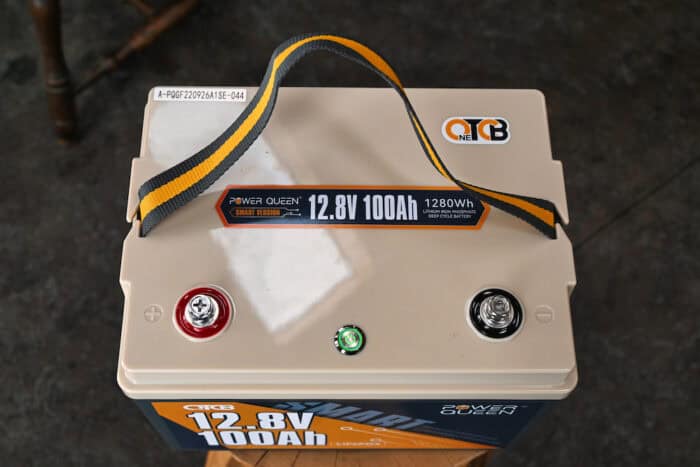
Power Queen recommends waiting 30 minutes after disconnecting all connections to the battery, before checking the voltage.
The recommended charging/discharging temperatures are as follows:
Charging: 32°F to 131°F (0°C to 55°C)
Discharging: -4°F to 140°F (-20°C to 60°C)
Storage: 14°F to 122°F (-10°C to 50°C)
I strongly recommend following these temperatures as much as you can to not risk damaging the cells permanently.
Ratings – Ampere hours (amp hours) and watt-hours
The battery is rated at 100Ah, which is 1280 watt-hours at 12.8V
The max continuous charge and discharge current is 100Ah, so you can technically pull the full 1280W and drain the battery within an hour.
One thing to note about that is that even though it’s a 100Ah battery and the max discharge current is 100Ah, does not mean that it will last exactly an hour when doing so.
The operating voltage of the battery is 12.8V, and the charging voltage 14.4V.
The SOC (state of charge) can be can be roughly estimated by the resting voltage, the numbers below are from the manual.
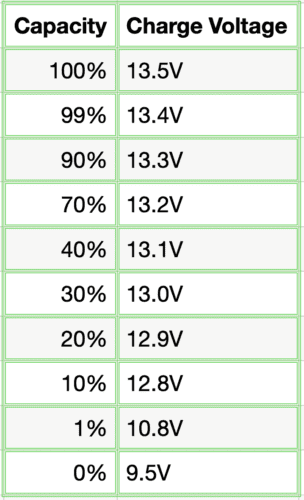
Safety features with built-in BMS
BMS is short for Battery Monitoring System.
The BMS is there to protect and prevent overcharging, over-discharging, overcurrent, and short circuits.
One feature I haven’t seen on any other lithium battery, related to the BMS, is the button on top between the terminals.
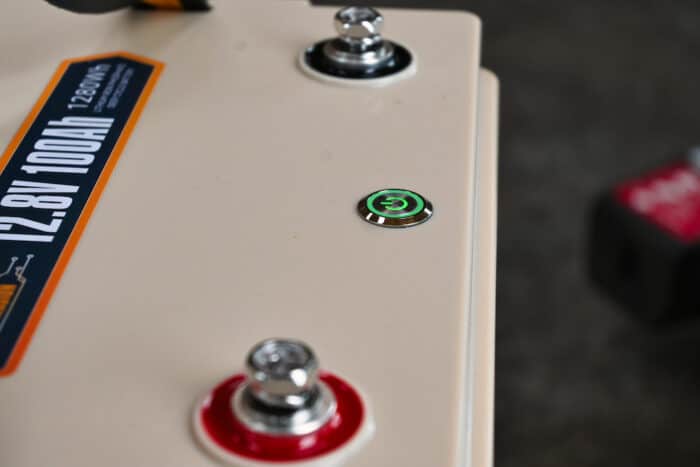
This button can be used to not only turn on and off the battery, but to see what the status is.
With the LED light in the button, you’ll quickly know if there is something wrong with the battery or the BMS.
- Green light – The button will blink green during the powering on proccess, and when the state of charge is below 25%. A solid green light means that it’s functioning like normal and has more than 25% capacity left.
- Orange light – A solid orange means that the BMS has kicked in to protect the battery. It can be due to any of the security features (under-voltage, over-current, over-temperature, low-temperature, or short circuit).
- Red light – A solid red light means that the battery is powering down. If it
- Light off – This means that the battery is either off or in sleep mode. It can’t be discharged when off, but can be both charged and discharged in sleep mode.
Pushing the button twice within five seconds will override the low temperature cutoff, and force the battery to recharge even in low temperatures.
I don’t recommend doing this unless you know what you’re doing. Charging lithium batteries in freezing temperatures can cause permanent damage to the cells.
Cycle life
After 5000 complete discharge cycles or after 12 years, the button might start blinking orange. Power Queen recommends replacing the battery at this point, but it’s not necessary.
You can still charge and discharge the battery as normal.
Expandability
The battery supports both parallel and series connections.
You can theoretically connect up to 16 identical batteries together for a 4P4S setup. This means that there are four pairs of parallel and four pairs of series.
It’s important that you use wiring and terminals that can handle the total voltage and amperage of the combined batteries.
The included manual has more important information about these configurations.
Design and what’s included
There is a strap handle on top that makes it easy to carry and transport the battery.
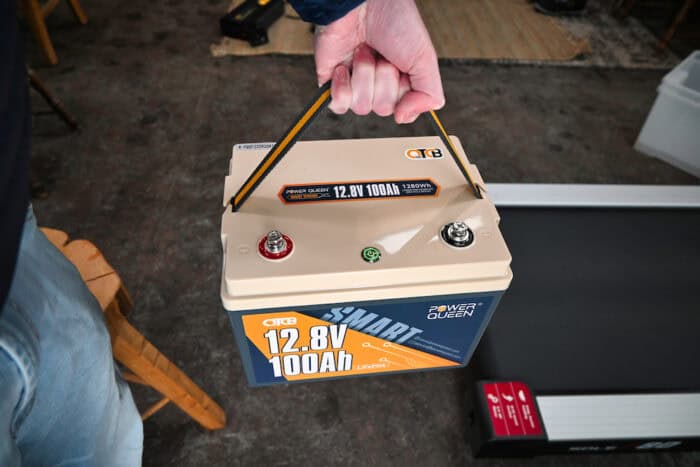
On top is also where you’ll find the two terminals, one positive and one negative. The power and status button is located between the terminals.
Power Queen includes four M8-14mm bolts and two terminal covers.
Size and weight
The battery weighs 24.25 pounds (11 kg) and measures 13 by 6.82 by 8.48 inches.
Review And Test Results
This is where I list what I like and dislike about the product I review.
What I Like
Large capacity for the money
Power Queen currently sells this battery for $459.99. For the amp hours and features you get, that’s a good deal.
Is it the best deal? Well, that’s not for me to say since it’s going to depend on whether you think the smart-features are worth it or not.
I did not have any problems pulling 1300W for an extended period of time from this battery.
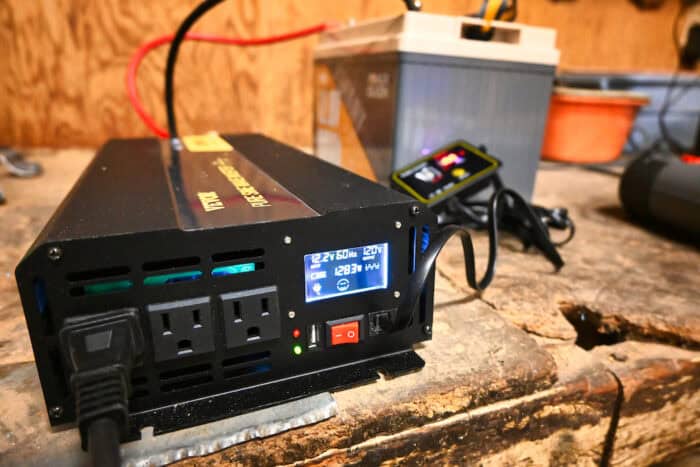
It would turn off at anything above 1350W after a while, so if you need to be able to power a device that requires more than that you’re going to need two batteries wired in parallel.
I was also able to pull the full 100Ah from this battery, it actually ended up being a couple of amps more than what it’s rated at.
Great BMS and smart-features
I like the button that functions as more than just a power button.
If you don’t have a battery meter or multimeter nearby, the lit button is an easy way to know if the battery is functioning as it should or not.
I also like that the BMS has low-temperature protection. If you replace your RV battery with this and spend time in cold climates, this is an important feature to prevent damage.
I did test the low-temperature protection in a garage where the temperature was close 20°F (I don’t recommend doing) and it kicked right in and prevented me from charging the battery even a little bit.
Very light compared to lead-acid batteries.
My 100Ah 12V AGM battery in my RV weighs 68 pounds, this battery weighs 24.25 pounds. That’s a huge difference, and makes it so much easier to deal with.
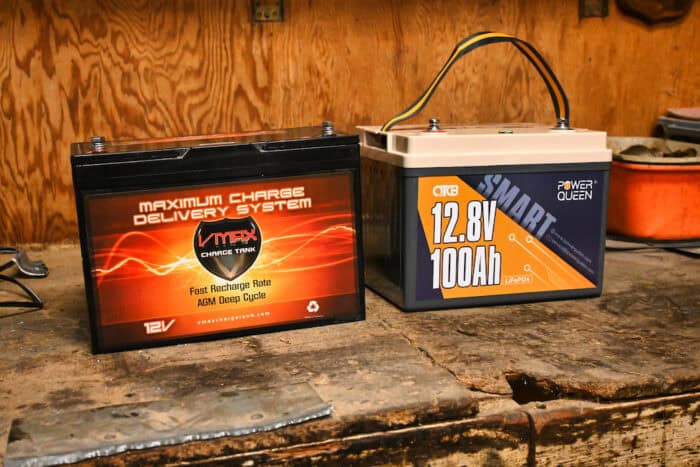
LiFePO4
Li-ion batteries are great, but LiFePO4 is arguably better.
They’re safer, last longer in terms of lifecycles, and can hold a charge a bit longer than Li-Ion.
But it’s when you compare them to lead-acid that you’ll start asking why lithium isn’t used everywhere.
LiFePO4 is efficient, reliable, durable and safe.
It might seem like a high upfront cost, but over time it’s going to save you money compared to lead-acid if used regularly.
What I Don’t Like
No built-in heating
First I want to mention that Power Queen does make a self-heating 100Ah 12V battery, but it does not have the power button.
The model I reviewed does not though, and that’s a limitation that will not be a problem for most people, but a dealbreaker for some.
In fairness most lithium batteries do not have self-heating capabilities, but I hope to see it become the standard.
The charging/discharge temperature limitation is simply a downside with lithium in general.
Frequently Asked Questions
Is it a drop-in replacement for my RV battery?
It might be, if the converter charger in your RV supports lithium.
I suggest reading the owners manual to find out what type of batteries the converter charger in your specific RV/camper supports.
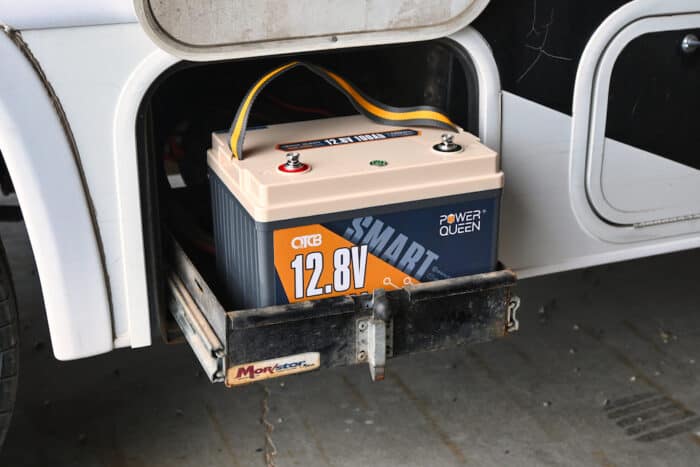
You also need to know how to wire the battery to your RV correctly.
If you’re using 6V batteries today, they’re most likely wired in series before they’re connected to your RV.
With two 12V batteries, you need to connect them in parallel for a 12V system.
What inverter do you recommend?
An inverter changes the DC battery power to AC current, and make it possible to power regular household 120V devices off of the battery.
I recommend at least a 1500W inverter, since the battery is rated for up to 1280W. Lookup the power requirements for the device you want to power to figure out whether the battery or the inverter is going to be powerful enough.
If you would like to double the maximum continuous output current you can configure two batteries together in parallel.
By doing this, the amperages will add up but the voltage will stay the same.
How do I charge the battery?
Battery charger – Power Queen sells a 24A LiFePO4 battery charger that can easily be connected and charge up the battery in about five hours.
If you have a battery charger already you need to make sure it supports lithium batteries, since they like to be charged a little bit different than the old lead-acid cells.
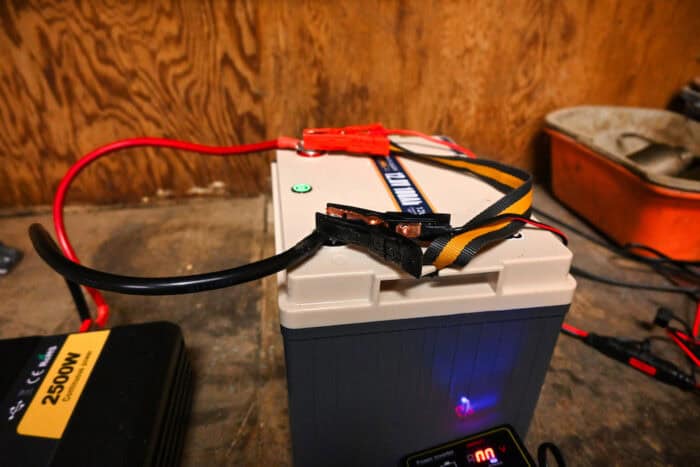
RV Converter/charger
As I mentioned earlier, you might be able to replace your current RV battery with this, but you first need to make sure the converter charger supports lithium batteries.
If your RV or camper is a couple of years old and you currently have lead-acid batteries it will most likely not have a converter charger that does support lithium.
Solar – See below.
How do I charge it with solar panels?
To charge the battery with solar panels you’re going to need a solar charge controller that supports lithium batteries, a solar panel, and some sunshine.
I recommend buying an MPPT solar charge controller like this one I reviewed from BougeRV, and at least 200W of solar panels.
Power Queen recommends 300W, since that should be able to charge up the battery within five hours in optimal conditions.
Please leave a comment down below if you have any questions.



What size battery cable connectors are used for the terminals?
Hi,
M8
Does it stay on after I push the power-on button or does it turn off automatically? I,e, any chance of it turning itself off in the middle of a camping trip?
Do I need to turn it off when not using it?